Visit Iceland by Campervan in Summer: A Guide
This post contains affiliate links for which Expedition Wildlife may receive a commission (where applicable) at no additional cost to you. This is not a sponsored post; we just like Cozy Campers :)
Situated in the wild North Atlantic Ocean, Iceland is a must-visit for anyone who loves dramatic scenery and adventure. Dubbed as the land of “fire and ice,” its varied landscape means visitors should spend as much time exploring the country as possible. Geysers, hot springs, and semi-dormant volcanoes, and vast glaciers and icebergs, are what give Iceland its now popular moniker.
Iceland is home to incredible wildlife, including arctic foxes and over half the world’s Atlantic Puffins, those lovable clowns of the sea. Don’t let anyone tell you there isn’t much wildlife to see in-country, as they are sorely mistaken… you just have to know where to look!
We took a ten-day road trip around Iceland by campervan, and it was one of our favorite trips to date. Keep reading to learn all about what you need to visit and see Iceland’s stunning natural beauty by camper!
Tip: Guide To Iceland is an incredible site with blog posts filled with information about traveling around Iceland – we used this as a major reference point for questions about getting around, camping, rules and regulations, and more.
Need more inspiration? Check out our 4K video of our Iceland adventure!
When to visit Iceland by Campervan
Deciding on the best time to visit Iceland largely depends on what you’re interested in seeing and doing while there.
Summer season is the high season
The roads are (usually) clear of snow and ice by June. The summer midnight sun is characterized by 24-hours of daylight, leaving plenty of opportunities for exploring.
If you’re interested in hiking and having the weather be closer to around 50 degrees Farenheight instead of freezing, summer is likely the best time for you.
PRO TIP: Because of the midnight sun in summertime, you can explore the country nearly ANY TIME of day.
That’s right. Want to see the Glacier Bay with literally not a soul in sight? Go at 2 a.m. when it’s perfectly light outside to enjoy and explore.
Tourist buses will begin arriving around 9 or 10 a.m. at the major tourist sites. We suggest flipping your sleep schedule to see those incredible places WITH NO ONE ELSE AROUND! You’re welcome.
Keep in mind, though, that summer in Iceland is cold! You likely won’t take off your fleece for the entirety of your visit.
Certainly, your swimsuit will only be suitable for the heated pools and hot springs, not the stunning stretches of beach along the hundreds of miles of coastline. Scroll to the bottom of this post for our recommended gear items.
On top of this, summer is when the costs for nearly everything are much higher, including car or camper rental and accommodation.
Winter also sees quite a few tourists, as people flock to see the Northern lights. Roads in certain parts of the country may be inaccessible due to the snow and ice. 4×4 vehicles will be required, especially in the far north, east, and center of the country.
Don’t let the prospect of cold weather, however, deter you from experiencing Iceland by campervan during this special time of year!
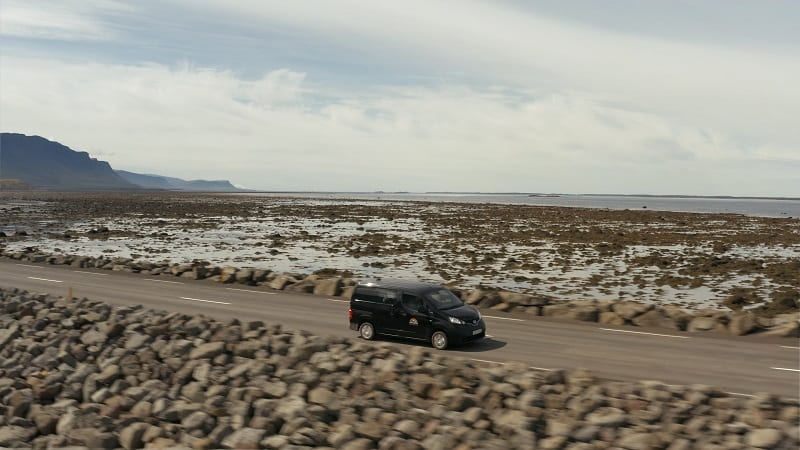
Oh, the places your camper can take you! Photo by Nathan Rolls
How to get to Iceland
Air
IcelandAir is one of the most reliable airlines traveling regularly to Iceland throughout the year, as they fly from many different locations in Europe and North America. Check out their route map here.
IcelandAir also allows for a seven-day layover possibility, where you can stay in-country on your ticket at no additional cost. This offer is valid for a seven-day visit on your way to another IcelandAir destination.
Now that WOW Airlines has gone out of business, SAS and EasyJet are the next two most traveled airlines to get to Iceland. Although there are others, check out sites such as Skyscanner, Kiwi, and Omio to get flight deals.
Try to book as far in advance as you can!
Water
If you’re feeling adventurous, you can also ferry or cruise to Iceland.
The ferry line is run by Smyril Line, which travels to Iceland from Denmark and the Faroe Islands. You also have the opportunity to stop over in the Faroes, if you so choose, along the way. We highly recommend a visit to the Faroes!
Check out their 2020 sailing schedule and prices here. Ultimately, the cost of getting to Iceland in this way is incredibly inexpensive. Just account for the two days it takes to get from Denmark to the Faroes and the extra day from the Faroes to Iceland. And don’t forget the Dramamine!
For more information on ferrying between these destinations, head over to Seat 61. This is my go-to site for travel by public transport between and within various countries.
The ferry, too, will drop you off on the far eastern part of the country, not the main city of Reykjavik. In this case, you’ll either need your vehicle on the ferry with you, or you’ll need to schedule at bus transfer with Strateo.
Getting Around Iceland
If you’re wanting to get off the beaten track, we think seeing Iceland by campervan is the best option.
See the next section on selecting a camper for how to go about doing this – we recommend Cozy Campers!
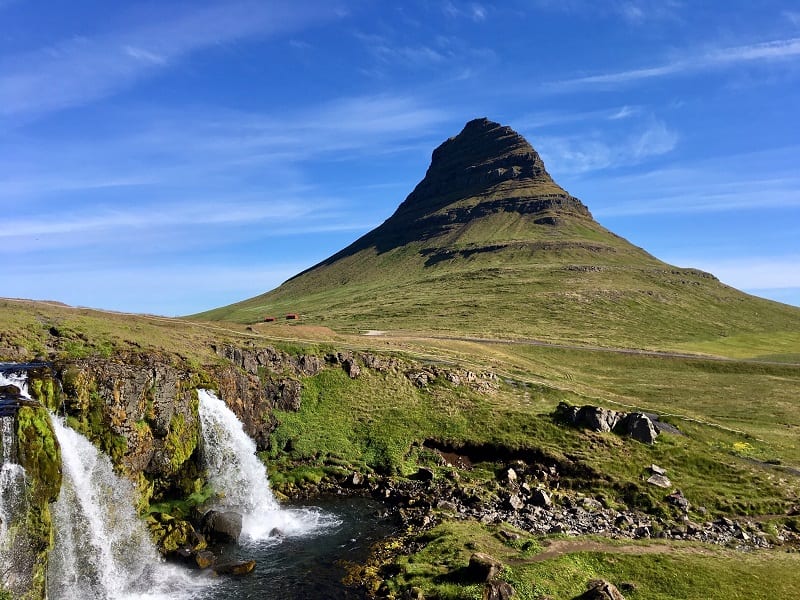
Seeing the famous Kirkjufell mountain and waterfall before all the tour buses arrive is a real treat! Photo by Christa Rolls
Alternative modes of getting around Iceland include…
Car
There are numerous car rental companies at Reykjavik Airport and in the city itself.
Note that Reykjavik is about a 45-minute drive from the Airport. Though it seems close on the map, the speed limits and roundabouts don’t allow vehicles to move quickly between the two destinations.
Check to see if your rental company offers a shuttle service for pickup. If not, you’ll need to grab a taxi or take the Flybus into the city.
Common rental companies such as Hertz, Enterprise, Sixt, and Budget can all be used. Other local companies, such as Reykjavik Rent-a-Car or Lava Car Rental are also available.
Book your vehicle well ahead of time, as the rates will skyrocket the closer you get to your travel dates. Also, if you rent within a certain period of time before your trip, you might be able to get an early bird discount. Inquire about this with the car companies.
Tour
If you aren’t interested in driving around, there are plenty of tour companies that will take you to some of the sites you wish to see from major towns such as Reykjavik or Akureyri.
Reykjavik Excursions, the operator of the Flybus, has tour destination packages available. Guide to Iceland has packages, too. There are MANY companies that offer tours in the country now, depending on your interests.
Intrepid Travel, Extreme Iceland, and G Adventures offer some more active tours, particularly Extreme Iceland, which offers glacier treks and caving experiences.
Local guides such as Tours by Locals and Stefan Tour Guide get great reviews and allow the opportunity for a more local look at the surroundings (with a much smaller group size than the larger companies).
Bus
Straeto Bus Line has local and regional buses if you don’t want to pay the fares for the Flybus or other tour lines. Note that local buses take longer since they make multiple stops. Their timetables may also not match up well with your arrival time!
If the timing works out well for when your flight gets in, you can take the Number 55 bus from outside the Reykjavik airport. The Number 55 goes to the BSI bus station in Reykjavik City Center for half the price of the Flybus (though you’ll tack on 20 minutes to your travel time).
Note some of the longer distance buses that can get you around many parts of the country. You can also get a “bus pass” from different companies, where you get hop-on, hop-off access to different locations around the country depending on the pass you purchase – See Camping Card’s Ring Road bus pass option here.
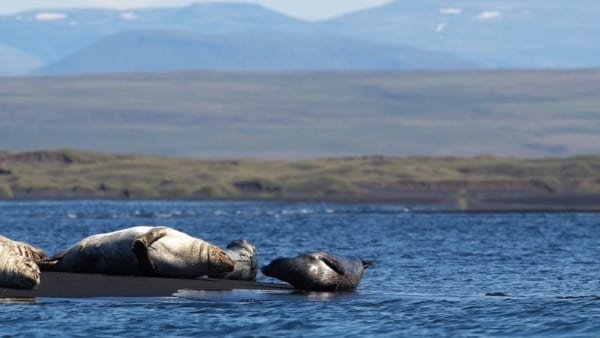
Wildlife of various kinds can be seen all around Iceland, including these seals, easily seen at Vatnsnes Peninsula! Photo by Nathan Rolls
Iceland by Campervan: Selecting your campervan company
Some of the top camper companies in Iceland are Cozy Campers, Go Campers, Happy Campers, Camp Easy, and Kuku Campers.
Go Campers, and now other companies, have a partnership with Camping Card (see Where to Camp in Iceland below). This gets their customers a Card discount if they purchase their camper trip through Go Campers.
Still, Cozy Campers won our hearts.
There are a multitude of components to consider when deciding on a camper company in Iceland. These are things you’ll want to keep in mind as you make your decision about who to book through, as they can make your trip more or less comfortable depending on your needs.
When seeing Iceland by campervan, note whether your rental includes the following options.
CDW (Collision Damage Waiver) Insurance
Surprisingly, most camper rental companies will include this in the daily cost. It waives the company’s opportunity to charge you a high deductible in the event there is damage to the car. It also covers some minor damages to the vehicle.
As we note later in “Navigating Iceland’s Roads,” even standard and well-traveled roads can be gravel or unpaved. The road conditions throughout most of Iceland increase your chances of minor damage to the car. So, at a minimum, having CDW is a necessity.
We recommend getting the comprehensive package to include roadside assistance, gravel protection, and ash protection (if the volcanoes are active). It’s pricier, but it was worth the peace of mind during our trip.
Linens
Clean, warm, cozy linens, including sheets, sleeping bags or duvets, and pillows are an excellent component to have included in your camper.
Sleeping bags take up a ton of space in your checked luggage and are just another thing to bring, so let the camper company do this for you.
Our sheets and duvets were so warm and cozy! We never worried about being too cold in the middle of the night.
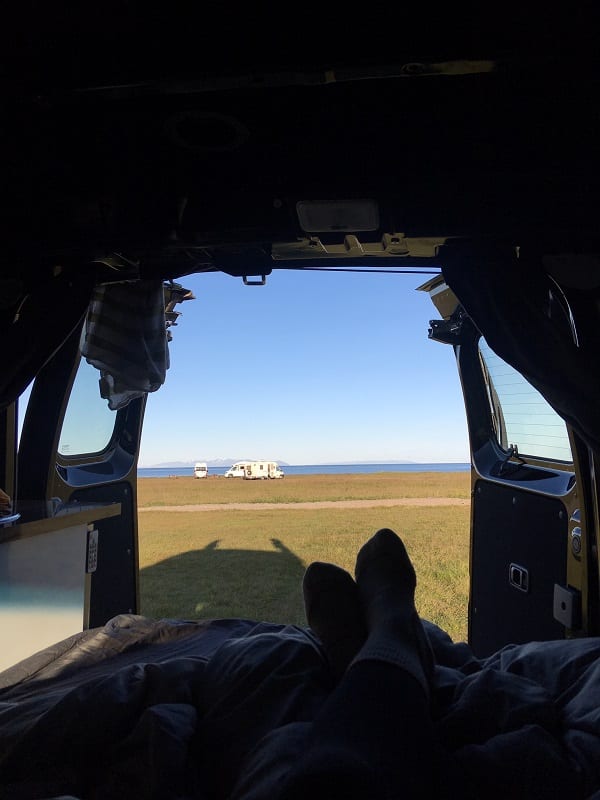
Relaxing in the back of our campervan, looking out to the sea! Note the snuggly duvet underneath. Photo by Christa Rolls
Kitchen sets
Campers typically include a portable one-burner stove and all the associated cooking and dining utensils.
However, not every camper comes with an electric cooler (similar to small refrigerators), “running water,” and a water reservoir.
A cooler, in particular, is especially helpful for keeping meats, cheeses, and other items that can spoil cold enough throughout the duration of your trip.
The “running water” is fed into the interior sink directly from the water reservoir and empties outside the vehicle. This helps to eliminate sink mess during cooking. All campgrounds will have access to running water and drinking water, but having it while you want to make dinner out on the road is an added nicety.
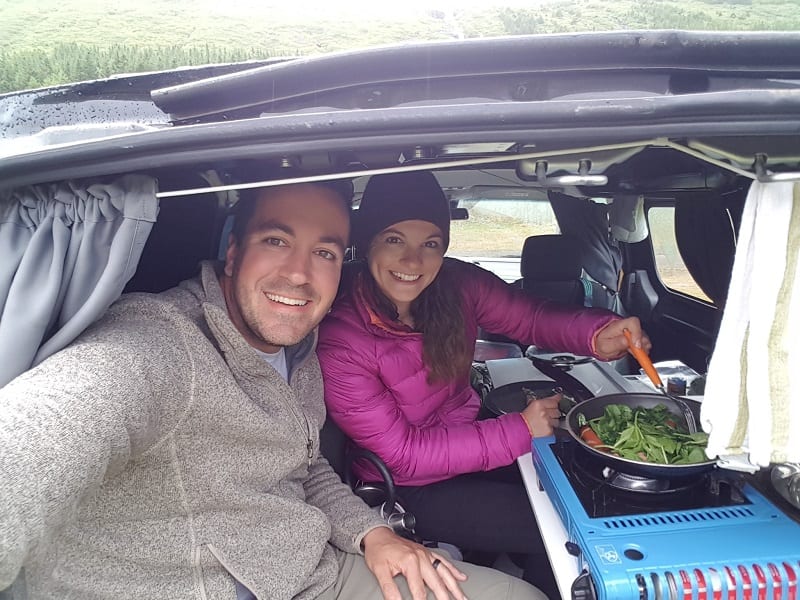
Us sitting in the back of our camper, cooking dinner! The whole kitchen set was included in our rental, and the pop-out table inside helped when it was too windy to stay outside. Photo by Nathan Rolls
Heating
Even in the height of summertime, it gets pretty chilly in Iceland. Having a heating system to warm the car up before bed and as you’re waking up in the morning is a really nice perk.
Having heat in the vehicle in winter is especially essential! Rental packages offered in wintertime should have heating units included in the cost. Renting a campervan in Iceland means needing a good way to stay warm!
Interior seating
This was a non-negotiable feature for us.
Many discount campers will have the whole back of the camper as a full bed. To access the kitchen and other cooking materials, you then need to open the back end of the car to set up the stove while standing outside. That is, unless, you want to cook on your bed.
We wanted a space where we could cook inside and stash our wet boots without having to stand outside or sit on the bed the whole time. Cozy Campers ONLY offers the more spacious, interior seating campers.
Changing up the interior space, though it’s small, gave us the flexibility we needed to maximize the space.
The weather in Iceland is fickle and the idea of cooking outside during bad weather sounded horrendous.
To us, this was an essential piece of the camper that really made our trip. Campers with this feature are pricier, but in our opinion, worth it.
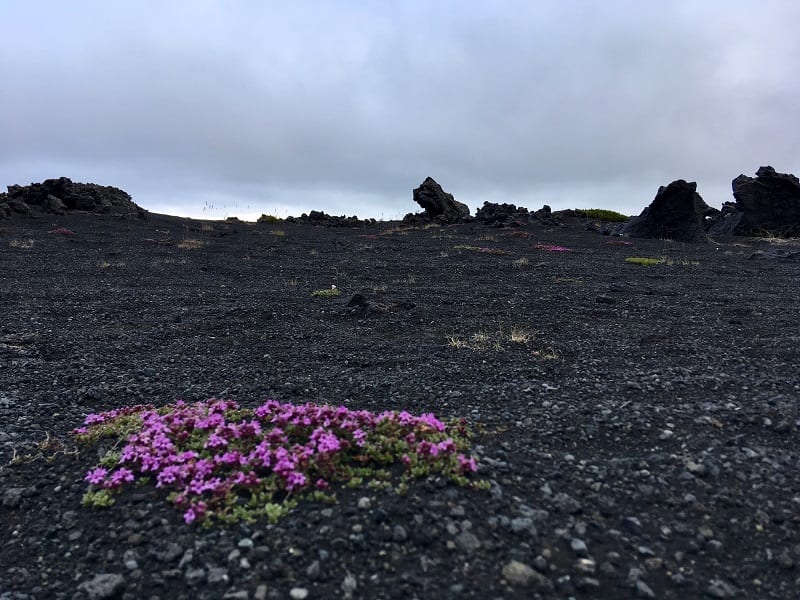
The scenery varies throughout Iceland so dramatically. In Myvatn, active hot springs and black, volcanic landscapes can be explored. Photo by Christa Rolls
Fuel discount card
Nearly all of the camper companies provide a discount card. The discount takes a few cents off per liter of fuel at select fueling stations.
Different camper companies will offer discount cards to different fueling stations. To get the discount, you’ll need to see which station your fuel card is for, and map those out ahead of time. Your camper company should supplement the fuel card with a map of all the fueling station locations in the country.
With how expensive it is to visit Iceland, saving a couple of bucks here and there helps.
Transfers to and from the airport
See if the rental company picks you up from the airport and drops you off.
The Flybus to and from the airport can cost upwards of $50 per person round-trip. Having this service included will surely save you a chunk of change.
Cozy Campers sent us a Flybus voucher directly. Although they didn’t pick us up directly, they paid for us to get to Reykjavik City Center, then paid for a taxi to take us to the Cozy Campers location.
Add-ons
There may be some add-ons you might like to have for your vehicle. These include a voltage converter (to switch the regular 12V vehicle plug in to a 220V plugin for phones, cameras, and other electronics), camping chairs, wifi pucks, and more.
Depending on the company, the price for these different add-ons can make a big difference in what you pay in the end.
I highly recommend at least the voltage converter and a couple of camping chairs. Even if you have a seating bench inside the vehicle, it’s great to sit outside on a nice day.
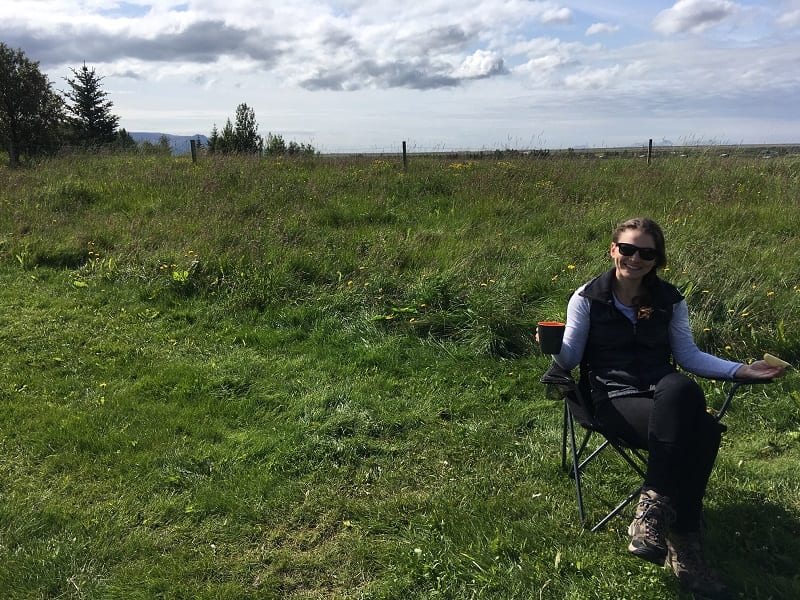
Enjoying breakfast on a nice, sunny Icelandic day! Photo by Nathan Rolls
NOTE that if you already have phone service for the EU or Europe, to include Iceland, don’t get a WiFi puck unless your data plan is extremely limited. WiFi only works in places where cell towers are located, so you won’t have internet access with either the puck or your data plan. I suggest this option only for those without a European (Iceland inclusive) data plan.
Cozy Campers also offers a camper with a sky roof to see the Northern Lights from the comfort of your camper! I don’t recommend this in summertime, only because you won’t be able to see the Lights with the midnight sun.
Why we love Cozy Campers?
Cozy Campers really hit the mark for us on all of the points we wanted in a campervan.
When you’re sleeping in a vehicle on the road, comfort was really a factor for us, and we got everything we needed with them.
Per their name, the camper really is a cozy space to rest and relax in between all the exploring you’ll do.
While the price for a camper is pricey, especially for the high season, consider that you’ll be getting your vehicle, accommodation, and place to cook food all in one.
The price of our Cozy Camper was comparable to Go Campers. This is the other company we were considering renting through as Cozy Campers doesn’t have a discount deal with the Camping Card. But, the amenities in the camper are what ultimately won us over. Also, the add-ons for Cozy Campers for extra fuel or camping chairs, for example, was fairly inexpensive compared to other companies.
The level of service offered by Cozy Campers, too, was really exceptional. We knew if we had any issues on the road that we’d be well taken care of.
The owner of Cozy Campers is a local to Reykjavik, and he saw the need for higher-end feeling campers without the serious price tag. Trust us on this one, give them a look! They made traveling Iceland by campervan cozy and fun!
Navigating Iceland’s roads
The major roads around Reykjavik are well-maintained and paved. However, once you begin driving (especially) into the north and east of the country, don’t be surprised that a major road turns to an unpaved one.
These unpaved roads are largely still well-maintained if it’s a major road system. Road workers will grade and add gravel to the road depending on the conditions.
Note that off-road driving in Iceland is illegal, as it can damage the sensitive vegetation underfoot. Only drive within designated road tracks.
Iceland’s roads are color-coded for accessibility, too – Green, Yellow, Blue, and Black.
“Green” and “yellow” roads, which are designated as suitable for nearly any vehicle, are not all paved. Be aware of this during your travels and when selecting your insurance package. Gravel damage to campers is the main reason that people get damage charges.
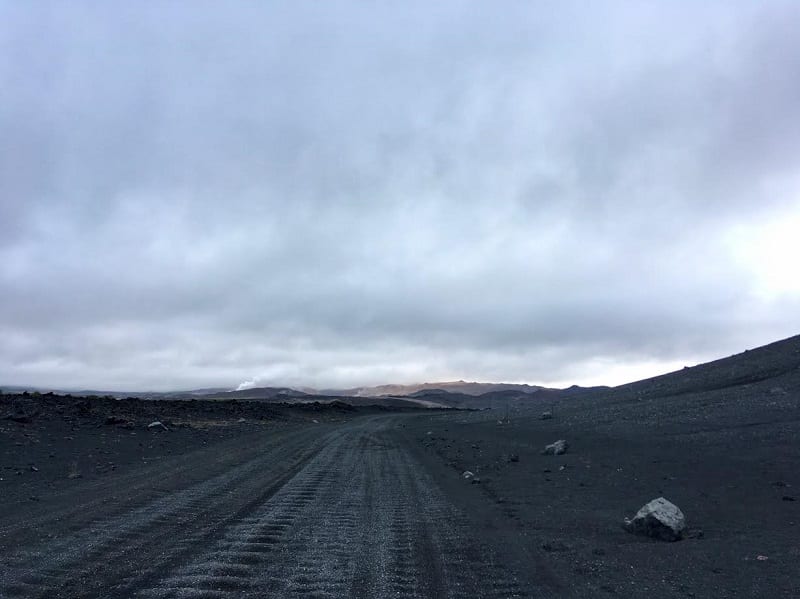
Depending on the vehicle you have, you may need to park on the main road, then walk the gravel trail to the Hverfjall Volcano trailhead. Photo by Christa Rolls
Note about F-roads and 4×4
Blue and Black roads require 4×4 capability. If there is somewhere in Iceland you want to visit that requires 4×4, consider this when selecting a vehicle.
F-roads (roads with an “F” followed by a number) are found in the interior of the country. They are really just tracks found in the ashen black soil and are closer to trails than an actual road.
Only vehicles that are approved for traveling on F-roads are allowed to visit these locations!
Fines can be imposed if you go on an F-road in an unsuitable vehicle. What’s more, the safety concern is the biggest issue. Lava rocks, stream fords, and massive potholes can comprise much of the F-roads. If you get stuck you’ll be having a less than stellar day.. especially since areas in the center of the country also often do not have cell phone service.
For road conditions around Iceland, visit road.is or call 1777 while in-country.
Where to Camp in Iceland
First and foremost, it is now ILLEGAL to free camp on the side of the road in Iceland at non-designated campsites.
Yes, people have ruined it for the rest of us, after not picking up trash and feces. You can receive a hefty fine if caught sleeping in an un-designated area.
The campsites are generally very enjoyable to stay at, though. Be a positive influence on others and spread the word!
There are many campsites in Iceland at which you can stay. Different ones will offer different kinds of amenities. Some offer WiFi, saunas, restaurants, washing facilities, hot showers, and electronics plug-ins.
If you map out the campgrounds at which you want to stay ahead of time, you can avoid disappointment if there are amenities you feel you can’t live without (like a hot shower).
Nearly every town has a public sauna or pool, too, which has access to shower facilities for a nominal fee.
Tip: Although many places accept card, get out some cash before you leave Reykjavik for coin-operated showers, for example.
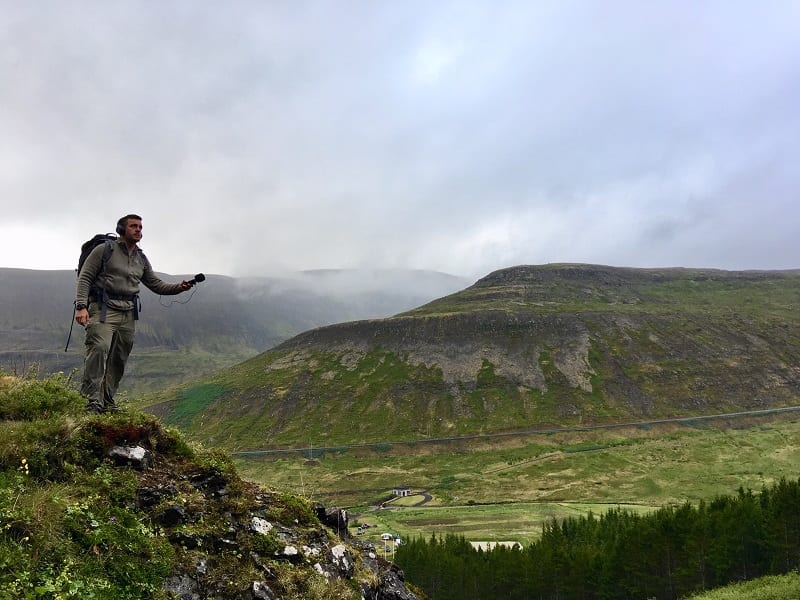
You can reach some beautiful spots just steps from some of Iceland’s campsites! Here, we were visiting a waterfall at the Isafjordur campground. Photo by Christa Rolls
Using the Camping Card
Tjalda is one of the only websites currently operating with information about *most* of the campgrounds in Iceland. The Camping Card website is the most user friendly. However, it only lists the sites where Camping Card is currently accepted.
If you purchase the Camping Card, you’ll be sent a whole booklet of the Camping Card-approved campgrounds. It details what to see and do around the area and all the included amenities. If you’re seeing Iceland by campervan, this is the way to go.
Note the Camping Card doesn’t include the 333 ISK per person overnight tax that you need to pay on arrival. You’ll pay this at every campground. All campgrounds working with Camping Card accept credit card for the added tax fee.
Even so, for two people traveling together, camping every night of the trip, and camping for more than five nights, the Camping Card pays for itself.
With the Camping Card, you have the flexibility to camp at any of their facilities without the hassle of pre-planning anything.
Reservations at campgrounds are also not necessary, even in the height of summer. You can simply show up and get out whenever you need to. We didn’t have any issues of getting a site, even after showing up at midnight to one campground!
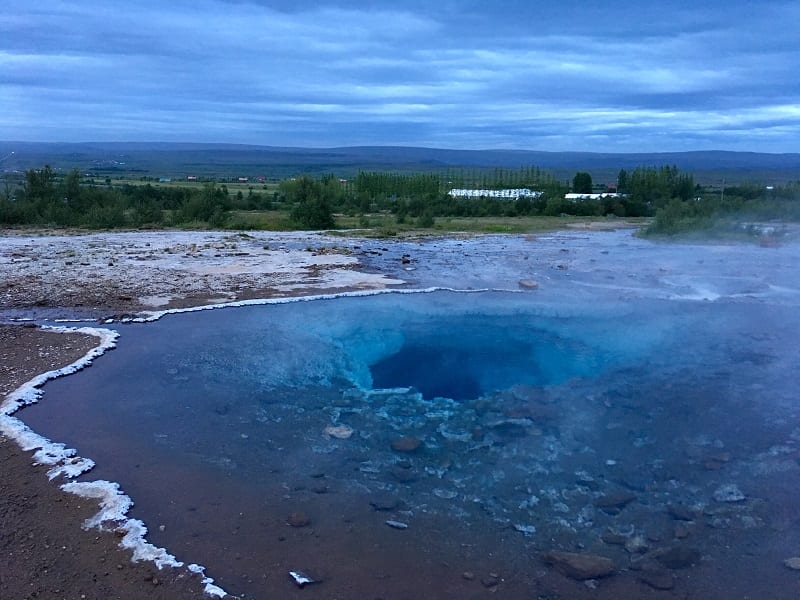
Not quite sleepy, we visited Geysir around midnight to watch the geysirs erupt and bubble. Photo by Christa Rolls
Food and Water in Iceland
Traditional food in Iceland is definitely something you need to try out at least one day during your visit, especially if you’re a lover of fish.
Food
Check with your campervan company on arrival to see if they have a food cabinet. Often, when people are finished with their trip, they’ll leave items they didn’t consume in a designated space at the rental facility.
See if there is anything in the food cabinet you would want to grab before you go!
For your camper trip, though, going to the grocery store and cooking up your meals is the way to go.
You won’t find grocery stores every place you go, or they’ll be seriously overpriced. Don’t be fooled, small-town grocery stores can still cost an arm and a leg.
Purchase food from the discount store, BONUS
The best discount grocery store is BONUS. It’s readily available in Reykjavik, and a couple of other places in Iceland, and has reasonable prices (comparatively).
Map out the closest one to where you pick up your camper, or along the way to your first destination, to get groceries before you get out of town.
We purchased:
- white bread for sandwiches
- fresh fruit
- cheese and yogurt
- pasta sauce
- veggies for cooking at dinner
- chicken for tacos
- hot dogs (hot dogs are famous in Iceland)
Your camper should come with dish soap and hand towels. We recommend picking up some paper towels for your cooking, too.
Planning everything out well, we spent a total of $60 for the first seven days of meals during our trip! Not bad, eh?
Pack food items from home
I’ve seen mixed information about whether to pack and bring food from home.
Our thoughts? Definitely pack some things from home if you’re visiting Iceland by campervan.
If you’re paying to check a bag anyway, we recommend bringing some pre-planned items!
We bought tortillas, white rice, couscous, and spaghetti very inexpensively at our local discount store. We also brought peanut butter for PB&J sandwiches, oatmeal for breakfast, and dried potato soup packages for lunch or dinner.
Measuring out the number of servings of rice, couscous, and pasta to bring with us helped us bring only what we needed. Packing spices, including spice packets for tacos, a mini salt and pepper shaker, a small shaker of garlic powder, and a small travel-sized container of olive oil prevented us from having to purchase a large container for only a 10-day timeframe.
I drink coffee and tea black, so bringing coffee grounds and doing a pour-over by bringing a portable pour-over (or renting a French press from your rental company is possible as well) on my own was easy to do. The Aeropress is also a great, portable, light option.
Total, we only spent around $20 on all these extra items, which would have easily cost us much more if we purchased them in-country.
Alcohol
We like to enjoy a nice alcoholic beverage at the end of the day, so we knew we wanted to grab some beer or wine.
If you want alcohol, YOU MUST purchase it at duty-free at the check bag station at the airport. Why? It’s SIGNIFICANTLY less expensive if you get alcohol at duty-free compared to anywhere in the country.
Want to go out for a beer? You’re looking at spending $10-15 on one small beer. At duty-free, however, you’ll spend about $15 for a six-pack, bringing your per-beer cost to only around $2.50, a much more manageable price.
The same goes for wine. Instead of opting for bottles, grab a box of wine at the back of the duty-free shop. Some people might scoff at having boxed wine, however, the options include some great Spanish, French, and Californian wines. We went with a delicious Cote du Rhone from France, so we really weren’t sacrificing quality!
A box of wine is 3 liters and costs around $35 on average, or around $12 per bottle. The cheapest low-end bottle of wine you’ll find in duty-free otherwise is $15. On the economy, you’re looking at an average of $20-30 for one bottle. Yikes!
If you do plan on grabbing alcohol at duty-free, consider this in your transport plans. I brought along a large reuseable bag in my carry-on and we used that for our alcohol and groceries.
Water
Campsites have potable, or drinking, water available, so don’t worry about having plenty of fresh water to drink throughout your trip.
Drinking water is safe, but it does have a slightly sulfuric smell, as the water comes from natural springs typical of the country and its surrounding, volcanically active landscape.
Because the water quality is very good and Icelandic people do not drink bottled water, SOME PLACES DO NOT SELL BOTTLED WATER.
We always bring along a reusable water bottle on our trips, and recommend this Camelbak bottle.
This likely won’t be an issue in tourist spots, but in the countryside, you may not be able to purchase water. The Icelandic people have really done a great job at reducing their plastic bottle consumption. The consensus is that the tap water is perfectly good to drink.
The only time I noticed the sulfur smell from our drinking water was when it was on my toothbrush. Otherwise, our water bottles never smelled strange or off-putting. We tend to be less picky about our tap water, though.
Keep in mind, too, that sheep grazing is allowed in much of the country. Drinking untreated water from springs is not recommended.
The only place we visited that touted no grazing and thus the ability to drink from the spring is in Hornstrandir Nature Reserve. However, it’s always best to err on the side of caution.
What is it like to explore Iceland by Campervan?
Great question.
We had SO much fun exploring Iceland in a campervan. The flexibility it afforded us in where we should spend more or less time made it so easy to visit where we wanted.
Yes, there are logistics to work out, but having breakfast by a glacier or dinner by a massive waterfall made this the adventure of a lifetime.
There is, however, limited space in the vehicle either way. Set the expectation with your camping partner ahead of time that you might need some space or “you” time if you’re spending many days in the camper! We set aside time every day for a nap, reading a book, or relaxing in the sauna.
Read more about exploring the remote Westfjords of Iceland and seeing Arctic Foxes here!
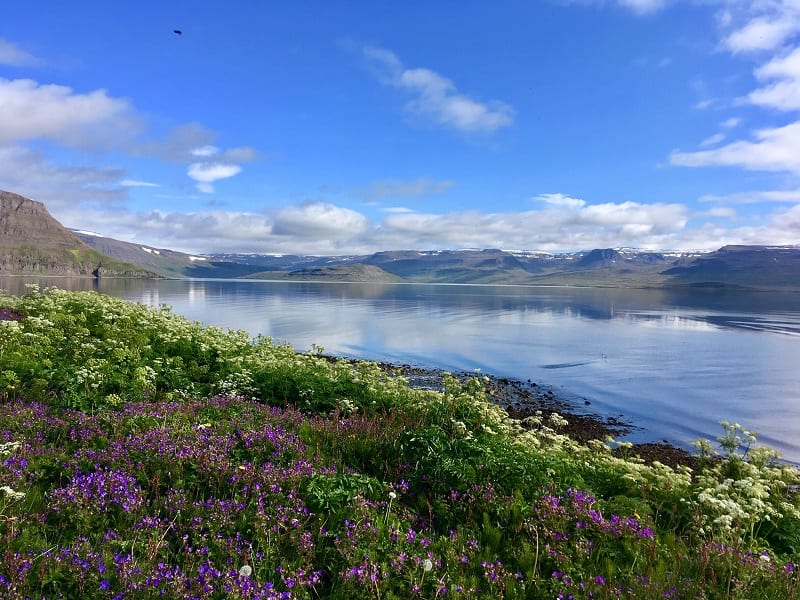
Tours don’t go all the way to Hornstrandir, so getting there by vehicle is a necessity. While it’s quite the journey from Reykjavik, it’s worth it! Photo by Christa Rolls
Cost of visiting Iceland by Campervan
We won’t beat around the bush – traveling to Iceland is expensive, but there are ways to cut costs.
- Consider bringing spices and grains with you in your checked luggage. Don’t bring anything with seeds, or meat and cheeses, which will be taken by customs.
- Map out where the BONUS grocery store is located throughout your trip.
- If you are staying for longer than five days at campsites, the Camping Card more than pays for itself, especially if you plan to use the facilities at the campgrounds.
- Utilize your fuel discount card by planning ahead the fueling locations specific to where your discount applies.
The total cost of our 10-day Iceland trip was under $4,000 in total for the two of us. Let me tell you, though, that the flexibility offered to us for the opportunities we had to see the country was 1000% worth it.
- Flight to Iceland: $650
- Campervan Rental: $1,450 (booking 5 months in advance; high season rate for the basic camper model)
- Hotel Accommodation: $40 for first-night arrival (Base Hotel at Keflavik Airport); $140 for last-night exploring Reykjavik (we liked this Airbnb)
- Camping: $27 for camping fee, $170 for Camping Card
- Dinner for one evening: $50 (one pizza and two beers)
- Groceries: $80 for store groceries, $50 for beer and wine at duty-free
- Fuel: $100
- Tours: $1,200 for seeing Arctic Foxes in Hornstrandir Nature Preserve – this was our splurge item!
Gear Recommendations for Iceland
Iceland’s fickle weather, to include cold and windy days, means needing to bring the right gear to prepare you, especially if you are staying in a camper.
Backpacking Gear
- Deuter Lite 60+10 SL Hiking Pack with Rain Cover (her)
- Gregory Baltoro 85L Pack (him)
- Small, lightweight, collapsible day pack (for day hikes)
- Atlas camera pack
Food and Water
- Camelback 3 L bladder (for day hikes)
- Camelback Water Bottle
- Spices (salt, pepper, garlic powder, mixed taco spices) and Olive oil
- Grains (tortillas, rice, couscous, spaghetti pasta, oatmeal – measured and portioned out for trip)
- Coffee and tea (coffee measured out for trip)
- Peanut butter, instant potato soup, dried fruit bars, dried fruit snacks
Clothing and Footwear
- Vasque hiking boots
- Three pair hiking socks (SmartWool and Darn Tough)
- Reef flip flops (or other house shoes)
- Three pair Patagonia hiking underwear (originally purchased on discount at REI)
- Two hiking bras (originally purchased on discount at REI)
- One pair Columbia convertible pants
- Two moisture-wicking long sleeved shirts
- Two moisture-wicking short sleeved shirts
- Patagonia fleece (given to me by a mountain hut manager after someone left it for a month)
- Smartwool long john pants (originally purchased on discount at REI)
- REI puffy jacket
- North Face rain jacket
- Columbia Rain Pants
- Buff neck warmer
- North Face glove liners
- Prana ear warmer
Emergency and First Aid
- First Aid kit: alcohol wipes, antibacterial ointment, antidiarrheal, antihistamines, ibuprofen, Dramamine, antacid, epipen, gauze, medical tape, small round of duct tape, safety pin
- Hiking whistle (check the chest buckle on your hiking pack – some have a whistle built in)
- Travel Insurance – we recommend this for every trip you take!
Health and Hygiene
- Toiletries: wet wipes, face wipes, toilet paper, hand sanitizer, nail clippers, contacts and glasses, sunscreen, mini toothbrush, toothpaste, sunscreen lip balm, collapsible hairbrush, care plus clean bio soap (biodegradable; for skin, hair, dishes, and clothes).
- Note if you bring your own toilet paper and a few plastic bags to use as trash bags, you won’t have to worry about buying these things in the country either.
- Lightweight camping towel
- Sunglasses and baseball hat
Extras
- Eye mask and ear plugs (in summertime, it will be light outside practically the whole day – an eye mask can help get you to sleep if your accommodation doesn’t have blackout curtains)
- Phone charger (with standard Size C/F European plug) and battery charger pack
- Dry bag and large trash bag to line the inside of our our packs (in addition to rain cover)
- Stuff sacks for organizing gear
- Bird ID book for Europe
- Binoculars
- QALO silicone ring
If you’re a birder and plan on trying to ID some of the birds you see on your trip, definitely bring along binoculars and a bird book!
Personal Items
- Cellphone
- Credit cards and ID/passport
Electronics
- Canon 5D Mark IV (best for videography)
- DJI Mavic 2 Pro Drone* (Fly More combo includes extra batteries, extra propellers, and a travel bag)
- GoPro Hero 7
- Microsoft Surface Go and 2 TB Hard drive (for on-the-go video and photo backup)
- Loads of extra batteries and memory card for each piece of electronics
Seriously, consider grabbing a GoPro for your adventures – it’s even waterproof!!
Note on Drone Use in Iceland
As with most locations, there are certain restrictions drone users must follow to be in compliance with local laws.
Equally as important is carefully watching how your drone impacts the wildlife around you.
Iceland home to many thousands of sea birds and other wildlife and these animals can be sensitive to disturbances caused by drones.
Because of how many tourists Iceland gets per year, more and more popular destinations are restricting the ability to fly drones. Hornstrandir Nature Reserve, for example, does not allow drone flight in the Reserve. This is for the protection of the birds and other animals that take refuge in this oasis.
We DO love being able to use our drone responsibly, though, so check out our favorite drones to fly and travel with.
The Mavic Air is more affordable and lightweight, however, the Mavic 2 Pro will be able to withstand those Faroese winds better! The Mavic 2 Pro also has slightly better image quality.
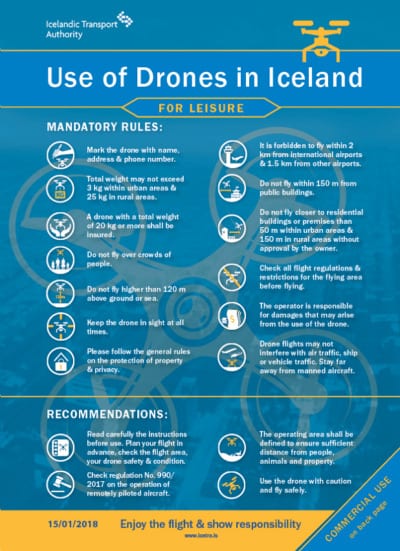
We LOVED our trip seeing Iceland by campervan. Are you considering a campervan trip? Let us know in the comments!
Happy travels!
Christa and Nathan
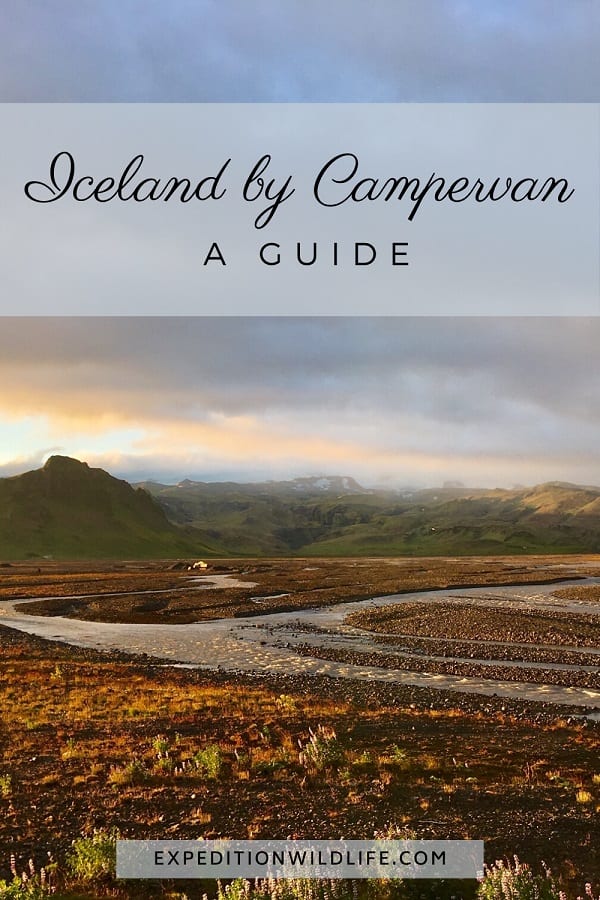

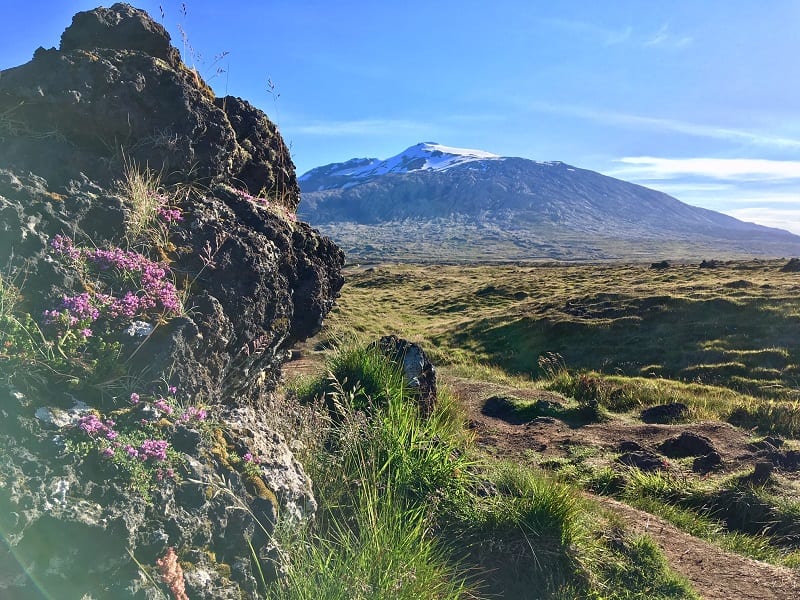



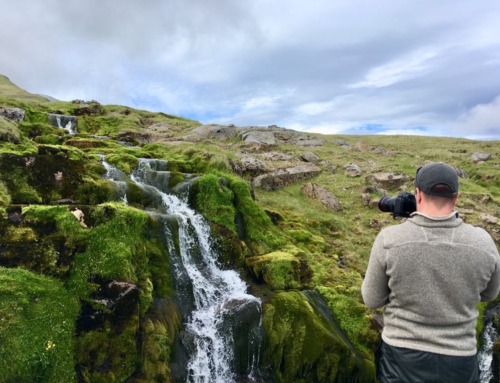
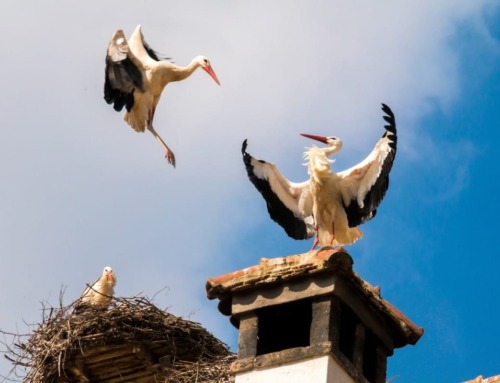
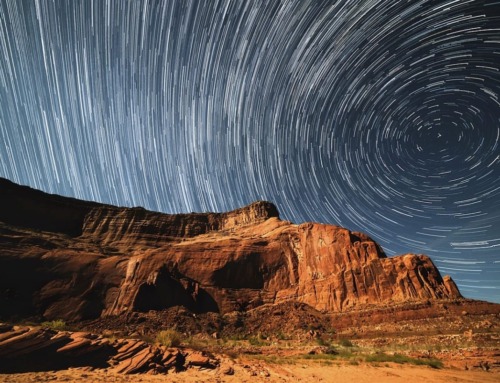

Leave A Comment